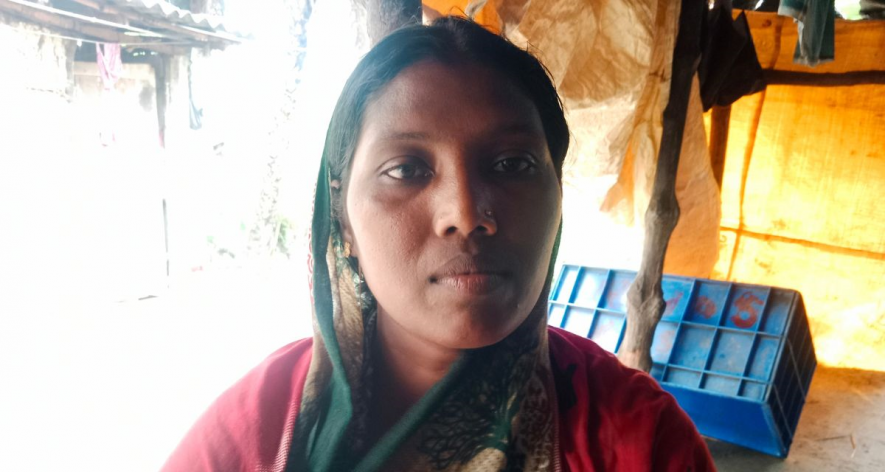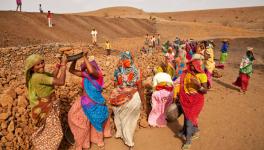Mamata’s Flagship Programme Erodes Panchayat Powers

Taposi Haldar, a resident of Damkal Kuimai village, South 24 Parganas district, had to cough up Rs 600 as a bribe to digitalise her ration card.
South 24 Parganas, West Bengal: For the residents of West Bengal’s Sundarbans region, climate change and poverty are two sides of the same coin. While Taposi Haldar (30), a resident of Damkal Kuimai village, South 24 Parganas district, has had her share of problems with these two, corruption has also impacted her.
Haldar earns Rs 100-Rs 400 when she goes fishing once in four to five days. Her husband Sanat Haldar works in a potato godown in Jalpaiguri.
Though her income is meagre, she had to cough up Rs 600 as a bribe to digitalise her ration card. “Our panchayat member does not hear us. We expect good housing and construction of river embankments to prevent breaches during cyclones,” says the mother of four.
The work on embankments was part of the Mahatma Gandhi National Rural Employment Guarantee Act (MGNREGA), which became defunct one-and-a-half years ago due to the Centre-state tussle. This has not only affected the work but also the livelihood of lakhs of MGNREGA workers.
Hailing from Haldar’s village, Sanatan Haldar (26) and his wife Joba Haldar (25) still await payment for the work done under the scheme. Joba says they sustain by catching fish and crabs these days while she also gets Rs 500 every month under the Lakshmir Bhandar scheme. The government provides five kg of rice for each family member.
“Everything happens as per the state government’s wish now. Two months ago, the Duare Sarkar (Government at doorstep) programme was held in our panchayat Nagendrapur. Earlier, gram sansad used to meet and decide on local issues,” says Sanatan.
Under the Duare Sarkar outreach programme, camps are organised to deliver services and enlist beneficiaries under, at least, 11 welfare schemes run by the Mamata Banerjee government. Government staff would reach the gram panchayat/municipal ward to provide information on welfare schemes.
Paray Samadhan, a community component of the programme, deals with citizens’ petitions seeking redressal of neighbourhood issues/needs. In a way, the programme limits the powers of panchayats and gives more control over affairs to ruling Trinamool Congress (TMC) workers.
“Government officials and TMC workers visit villages under the programme. But people are still disappointed because their problems are not resolved. If only the government’s attitude is positive, the lowest tier of Panchayati Raj Institutions will work effectively,” CPI(M)’s state committee member Meenakshi Mukherjee tells 101Reporters.
Powers and duties
“As the gram panchayats in the state are quite large in size, having a population of 20,000-30,000, they have been subdivided on ward basis by amending the Gram Panchayat Act. For each ward, constitution of gram sansad has been made mandatory. Gram sansad is constituted with all the voters in a constituency of the gram panchayat,” says an explanatory write-up published in Odisha Review.
Gram sansad meetings are instruments of direct people participation in the planning process and monitoring of elected representatives, the write-up reads.
“Under the laws, the gram sansad is supposed to (i) guide and advise the gram panchayats with regard to schemes for economic development and social justice undertaken or proposed to be undertaken in its area; (ii) identify or lay down principles for the identification of beneficiaries for various poverty alleviation programmes; (iii) constitute beneficiary committees for ensuring active participation of the people in implementation, maintenance and equitable distribution of benefits of schemes in the area; (iv) mobilise mass participation for community welfare, and programmes for adult education, family planning and child welfare; and (v) record its objections to any action of the village council chief or any member of the village council for failure to implement development schemes properly or without the active participation of the people of the area.”
The powers and duties of the gram panchayat include sanitation, drinking water supply, maintenance and repair of public streets, removal of encroachments, and organising voluntary labour for community work and work for uplifting its area. Gram unnayan samiti, on the other hand, assists the gram sansad to prepare its five-year and annual plans, which form the basis of the gram panchayat plan.
A Gram unnayan samiti is constituted at a special meeting of the gram sansad and has an elected panchayat member, the candidate who finished second in polls and representatives from other social spheres.
The samiti identifies the needs of the sansad area through participatory methods and prepares budget. It helps the gram panchayat to make both assessment and realisation of tax, and prioritise the projects and schemes for implementation using the available resources and in consultation with the villagers.
Promoting livelihood opportunities for all adult members of the sansad through proper and planned utilisation of available resources, including greater access to credit from financial institutions or gram sansad fund is another area of priority.
Spreading awareness on livelihood, health, nutrition, education, gender and environment is another function. It also tries to mobilise people around the gram sansad for the expansion of social opportunities and in the process link up the activities of the sansad with those of the gram panchayat concerned.
Meetings, discussions on the back burner
The gram sansad holds a meeting of the entire electorate of a constituency once in six months (first in November and second in May) to discuss local needs, new programmes, choose beneficiaries of existing programmes, review the past and proposed programmes, and inspect the accounts of expenditure and budgets of the panchayat.
Each village within a gram panchayat will have its own gram sabha which meets annually (in December after the completion of gram sansad’s half-yearly meeting) to review the proposed budget for the next year and the previous year’s performance. The decisions of the gram sansad are discussed in the gram sabha.
“Both gram sansad and gram unnayan samiti have been rendered inactive after the TMC came to power. Their strength has been lost ... In the Duare Sarkar programme, TMC leaders and bureaucrats aligned to the ruling party assume the duties of the panchayat,” Anuradha Talwar, state committee member, Paschim Banga Khet Mazdoor Samity, tells 101Reporters.
Sariful Malik, from the Indian Secular Front, is the newly elected panchayat member from Chalta Beria, Bhangar-2 block of South 24 Parganas. “TMC workers stop opposition parties from contesting elections and do not give them a chance in matters related to the panchayat,” he claims.
Kankandighi panchayat chief Purnima Kar, from the TMC, however, claims that all panchayat committees hold meetings in her place. Her husband Govindchandra Kar says gram sansad meets twice a year and decides on development schemes, including road construction and identifying beneficiaries for tube wells. Both claim that the Opposition’s views are heard and considered important while taking decisions. Nagendrapur and Kankandighi panchayats are adjacent to each other.
One-tenth of the total members should form a quorum for a gram sansad meeting failing which an adjournment meeting can be held. The state government has been accused of using this provision of the West Bengal Panchayat Act, 1973, to run the show using government staff and thus override the powers of local bodies.
People in rural parts of south and north Bengal still remember the gram sansad meetings. “Democracy is dead, and the government is responsible for it. Neither gram sansad nor gram unnayan samiti meets,” says Navo Kumar Laskar, an MGNREGA worker from Damkal-3, South 24 Parganas.
Kolkata-based senior journalist Chandan Das explains further. “If these forums function, issues will have to be discussed there. But this is not the TMC culture. For the sake of showing off, they hold gram sansad meetings at some places. But even there, the TMC workers rule the roost.”
Das emphasises, “West Bengal does not need the Duare Sarkar programme. By attending them, you can only fill up forms for government schemes. You cannot register a complaint there. What we really need is elected panchayat representatives to whom the public can complain or speak their mind.”
Even the July 8 panchayat election was announced hastily, a day after Rajiv Sinha—a former chief secretary— assumed the office of state election commissioner on June 7.
“The usual practice of holding an all-party meet before announcing election dates was given a miss. Unlike the four-phase polls of 2018, elections were scheduled in a single phase this time,” says Mohammad Abdul Malik Mollah, the Indian Secular Front’s district president for South 24 Parganas.
Rahul Singh is a West Bengal-based freelance journalist and a member of 101Reporters, a pan-India network of grassroots reporters.
Get the latest reports & analysis with people's perspective on Protests, movements & deep analytical videos, discussions of the current affairs in your Telegram app. Subscribe to NewsClick's Telegram channel & get Real-Time updates on stories, as they get published on our website.
























